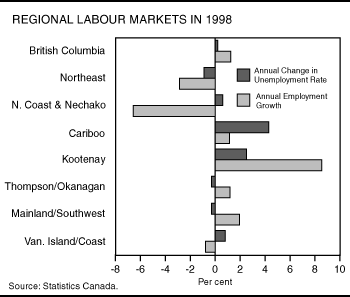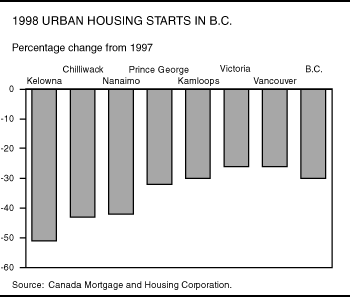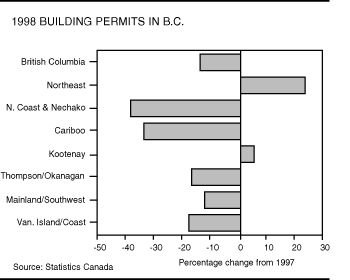REGIONAL ECONOMIC DEVELOPMENTS
The overall provincial economic slowdown in 1998 masks the varying performances of regions and communities across the province. Falling commodity prices and weak demand from Asian markets directly contributed to the reduced production and shutdowns of mines and forest product operations. Despite difficult conditions in the resource industries, employment rose and the unemployment rate fell in several regions. The province-wide decline in the housing market was greatest outside the two major metropolitan areas. A more diversified regional economy is gradually emerging, spurred by the resource downturn.
Two Economies?
It is often said that there are two economies in British Columbia: Vancouver and Victoria and the rest of the province. In reality, the distinction is more between urban British Columbia — Vancouver, Victoria, Kelowna, Kamloops — and the smaller communities — Smithers, Tumbler Ridge, Kitimat. Many of the larger cities have more diverse economies than was the case 20 years ago. As a result, they are now better able to withstand downturns in key sectors of their economies.
Population
British Columbia's population grew 1.3 per cent in 1998. Most regions experienced population growth, with the Mainland/Southwest and the Thompson/Okanagan growing the fastest at 1.5 per cent. Population grew the slowest in the Kootenay and Vancouver Island/Coast regions, while it declined on the North Coast.
Employment and Labour Markets
More than half of the regions experienced employment growth in 1998 (see chart). The Kootenay region had the fastest employment growth (8.6 per cent). The Mainland/Southwest accounted for the largest absolute number of new jobs and had the second-fastest employment growth rate. Employment declined 6.6 per cent in the North Coast/Nechako, and 2.9 per cent in the Northeast. These declines were due to weakness in the forestry, mining and fishing industries. After losses in 1997, employment rose 1.1 per cent in the Cariboo, despite several sawmill closures. In the Thompson/Okanagan, employment rose 1.2 per cent after strong growth in 1997. The unemployment rate ranged from 14.6 per cent in the Cariboo to 4 per cent in the Northeast. The Northeast unemployment rate has since increased to 6.9 per cent. The chart shows the changing patterns of employment and unemployment rates in the various regions.

Housing Markets and Construction
Lower in-migration and consumer confidence contributed to the weakness in housing markets across the province in 1998. Provincial housing starts declined 32 per cent. Sales of existing homes fell 23 per cent.
Housing starts fell 26 per cent in both Victoria and Vancouver in 1998, while home sales fell 15.6 per cent and 27.5 per cent, respectively in the two cities. Kelowna experienced the largest decline in housing starts among major cities. Two smaller communities, Dawson Creek and Fort St. John, recorded large increases in housing starts in 1998, reflecting strong activity in the Northeast's energy sector.
House prices fell 3.6 per cent across the province with the largest percentage declines in the south Okanagan and Sunshine Coast. The north Okanagan was the only region where prices rose. The value of building permits fell in most regions, reflecting lower housing and commercial activity. A 31 per cent increase in non-residential construction boosted the overall value of building permits in the Northeast.


Regional Resource Sector Developments
In 1998, resource-dependent regions experienced weakness in economic activity, resulting from temporary production cuts or permanent closures of mines and mills.
In the forest sector, layoffs took place in several regions during the year, including shutdowns at several Canfor mills around the province, at Northwood Pulp and Timber Ltd. in Prince George, and at Doman/Western Pulp Ltd. operations on Vancouver Island. Recently, Doman/Western Pulp workers were recalled and Canfor announced a $24 million expansion for the Fort St. James division over the coming year. Coastal forestry operations were affected by reduced demand from Asia, while the Interior benefited from a record year for U.S. housing starts.
Copper production increased 29 per cent through August 1998. This large increase reflects the opening of three new mines between the fall of 1997 and mid-1998: the Mount Polley copper mine in the Cariboo; the Kemess South copper-gold mine and the Huckleberry mine in the Northwest. Gibraltar Mines recently closed its mine near Quesnel. Highland Valley Copper has announced that it will close its Logan Lake operation, but negotiations are underway with the provincial Job Protection Commission. The owner of the Kemess mine, Royal Oak Mines, is under court protection from its creditors. On March 19, one of the creditors sought to put the firm in receivership. The Myra Falls zinc and copper mine on Vancouver Island will re-open ahead of schedule following three months of rehabilitation and development work.
The coastal fishing industry was hit hard for the second straight year by low salmon stocks, reduction of harvesting quotas and boat license buy-backs. Sports fishing also suffered as conservation measures resulted in reduced bookings at fishing resorts. Governments and the industry are working to win back sport fishing tourists.
Traditional Industries Diversify, New Industries Emerge
Non-resource activities helped sustain and diversify some regional economies in 1998.
Agriculture and the agri-food industry continue to play an important role in the economies of the Okanagan, the Cariboo, the Fraser Valley, the Northeast and the east coast of Vancouver Island. In 1998, the value of British Columbia's foreign agricultural exports rose 10.1 per cent, although farm cash receipts changed little. Some British Columbia agriculture producers, including apple growers, are facing lower prices for their products.
One example of diversification in the agriculture sector is the province's wine industry, located in the Okanagan and on southern Vancouver Island. More than 2 million litres of Vintners Quality Alliance (VQA) wines valued at $32 million are now sold annually. Since 1991, VQA sales have grown nearly 30 per cent per year. In addition, many wineries help boost local tourism with wine tours and tastings.
The ski industry continued to expand in 1998. Skier visits to British Columbia are up 15 to 20 per cent, almost doubling the province's market share of skier visits to the Pacific Northwest. The Whistler/Pemberton area grew rapidly in 1998, with many new resort properties added. However, as in the rest of the province, real estate prices slipped. Other cities, such as Prince George and Kimberley are developing tourism infrastructure such as new convention and ski facilities. In Ucluelet, Roots Canada and Coast Resorts are building a $60 million dollar resort aimed at the eco-tourist. In Victoria, the Leonardo exhibit at the Royal British Columbia Museum drew more than 450,000 visitors, during what is usually a slow period for tourism. In addition, film production hit a record high in 1998, with $808 million (up 28 per cent) spent on feature films and television production, behind only Los Angeles and New York.
Some of the new capital projects underway or expected to get underway in different regions in 1999 include:
- a new $20 million sulphur terminal in Prince Rupert;
- the upgrading of Keenleyside and Brilliant dams in the Columbia-Kootenay region;
- the Island Cogeneration Project north of Campbell River on Vancouver Island;
- the Alliance Pipeline project in the Northeast and two others in the south and Interior; and
- the new Royal Bay community being developed in south Colwood, west of Victoria.
British Columbia has always attracted more than its share of Canadians seeking warmer climates for retirement. For many years, the larger cities received most of retirees. As housing costs have risen, retirement migration is increasingly attracted to smaller, less expensive communities on Vancouver Island, the Okanagan and the Kootenays.